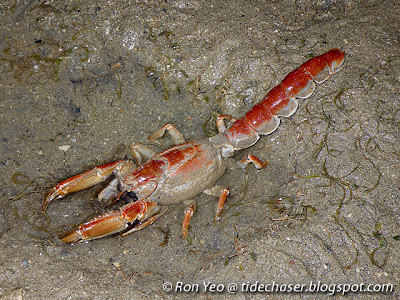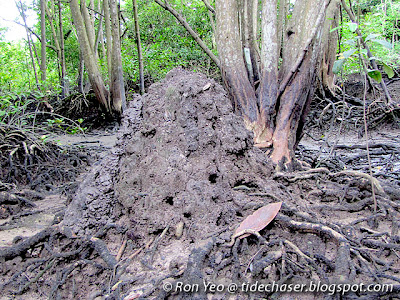Gebiideans (phylum Arthropoda, subphylum Crustacea, class Malacostraca, order Decapoda, suborder Pleocyemata, infraorder Gebiidea) are typically burrowing crustaceans with elongate and somewhat flattened abdomens. They are usually found in soft-bottoms of intertidal or subtidal areas. Members of this infraorder that have heavily calcified exoskeletons with spines and tubercles are commonly referred to as mud lobsters, while the more delicate members are usually referred to as mud shrimps.

All gebiideans have strong claws for burrowing, and many species build complex branching burrows in the ground. They mostly feed on decaying organic materials (or detritus), bacteria and other organic matter in the substrate.
Some species may appear similar to the coral ghost shrimps of the infraorder Axiidea, but can be distinguished from the latter by having pincers on the first pair of legs, and very reduced or no pincers on the second pair, instead of having well developed pincers on the first two pairs of legs.
Gebiideans are decapods, and like other members of the order Decapoda, they have five pairs of legs ("deca" means "ten", while "poda" means "feet"). Their body comprises three main parts - a head with five segments, a thorax with eight segments, and an abdomen with six segments. The head is fused with the thorax to form a cephalothorax. The abdomen ends off with a tail-like structure called a telson, and a flattened tail fan is present at the tip.
They have separate sexes, and the females carry the eggs until they are ready to hatch.
In Singapore, I have seen mud lobsters of the family Thalassinidae and mud shrimps of the family Upogebiidae.
A) Mud Lobsters (Family Thalassinidae)
Mud lobsters (family Thalassinidae) are lobster-like crustaceans that live in underground burrows in coastal areas.

Many are found in mangroves, though some also build their burrows along tidal rivers or other coastal habitats on upper shores with soft substrates. Some of the burrows can be very complex with numerous tunnels. As the mud lobster digs into the substrate, the excavated soil is deposited on the surface, and eventually pile up into a mound which can be over a metre tall, appearing much like a miniature volcano.

The mud lobster mound is a very important component in the mangrove ecosystem. The complex burrow systems provide shelter for various other animal species, such as ants, snakes, crabs, lizards etc. Plants also grow on the mound, as the soil that made up the mound are full of nutrients - the mud lobsters thus help to bring nutrient-rich soil from underground to the surface. In addition, the taller mounds are not covered in sea water during high tide. As such, local ecologists often refer to mud lobster mounds as "mud lobster condominium" - they are like "apartments" built by the mud lobsters, but used by many other species.
Mud lobsters are sometimes consumed in the region, and in some countries in the region they are consumed as a remedy for asthma.
Six species of mud lobsters are recorded from Singapore, and so far I have only photographed two of them.

The Scorpion Mud Lobster (Thalassina anomala) is lobster-like, reddish in colour with an elongate abdomen. It is usually found in muddy substrates, and appear to prefer areas with more vegetation. It can get to about 30cm long.

The Kelanang Mud Lobster (Thalassina kelanang) is very similar in appearance to the previous species. It is more commonly found in sandy substrates, and appear to prefer more open areas. The biggest I have seen is about 20cm long.
On the field it can be tentatively distinguished from the previous species by the row of 13-20 blunt spines on the upper edges of its claw, and also by the differences in the markings on the head and the first segment of the abdomen.

In the above picture, the left two images are those of Thalassina kelanang, while the ones on the right are those of Thalassina anomala. Note the differences in the lengths of the ridges on top of the head, and also the aspect ratio of and the markings on the first segment of the abdomen.
B) Mud Shrimps (Family Upogebiidae)
Mud shrimps (family Upogebiidae) appear like small mud lobsters, except that the tail is often broadly fan-shaped. They burrow into the substrates in intertidal areas, and some species even bore into corals. They generally do not build mounds like the ones built by mud lobsters though. They are sometimes confused with the coral ghost shrimps of the infraorder Axiidea, but can be distinguished from the latter by having pincers on the first pair of legs, and very reduced or no pincers on the second pair, instead of having well developed pincers on the first two pairs of legs.

The above picture features an unidentified mud shrimp. It is about 8cm long.
References

All gebiideans have strong claws for burrowing, and many species build complex branching burrows in the ground. They mostly feed on decaying organic materials (or detritus), bacteria and other organic matter in the substrate.
Some species may appear similar to the coral ghost shrimps of the infraorder Axiidea, but can be distinguished from the latter by having pincers on the first pair of legs, and very reduced or no pincers on the second pair, instead of having well developed pincers on the first two pairs of legs.
Gebiideans are decapods, and like other members of the order Decapoda, they have five pairs of legs ("deca" means "ten", while "poda" means "feet"). Their body comprises three main parts - a head with five segments, a thorax with eight segments, and an abdomen with six segments. The head is fused with the thorax to form a cephalothorax. The abdomen ends off with a tail-like structure called a telson, and a flattened tail fan is present at the tip.
They have separate sexes, and the females carry the eggs until they are ready to hatch.
In Singapore, I have seen mud lobsters of the family Thalassinidae and mud shrimps of the family Upogebiidae.
A) Mud Lobsters (Family Thalassinidae)
Mud lobsters (family Thalassinidae) are lobster-like crustaceans that live in underground burrows in coastal areas.

Many are found in mangroves, though some also build their burrows along tidal rivers or other coastal habitats on upper shores with soft substrates. Some of the burrows can be very complex with numerous tunnels. As the mud lobster digs into the substrate, the excavated soil is deposited on the surface, and eventually pile up into a mound which can be over a metre tall, appearing much like a miniature volcano.

The mud lobster mound is a very important component in the mangrove ecosystem. The complex burrow systems provide shelter for various other animal species, such as ants, snakes, crabs, lizards etc. Plants also grow on the mound, as the soil that made up the mound are full of nutrients - the mud lobsters thus help to bring nutrient-rich soil from underground to the surface. In addition, the taller mounds are not covered in sea water during high tide. As such, local ecologists often refer to mud lobster mounds as "mud lobster condominium" - they are like "apartments" built by the mud lobsters, but used by many other species.
Mud lobsters are sometimes consumed in the region, and in some countries in the region they are consumed as a remedy for asthma.
Six species of mud lobsters are recorded from Singapore, and so far I have only photographed two of them.

The Scorpion Mud Lobster (Thalassina anomala) is lobster-like, reddish in colour with an elongate abdomen. It is usually found in muddy substrates, and appear to prefer areas with more vegetation. It can get to about 30cm long.

The Kelanang Mud Lobster (Thalassina kelanang) is very similar in appearance to the previous species. It is more commonly found in sandy substrates, and appear to prefer more open areas. The biggest I have seen is about 20cm long.
On the field it can be tentatively distinguished from the previous species by the row of 13-20 blunt spines on the upper edges of its claw, and also by the differences in the markings on the head and the first segment of the abdomen.

In the above picture, the left two images are those of Thalassina kelanang, while the ones on the right are those of Thalassina anomala. Note the differences in the lengths of the ridges on top of the head, and also the aspect ratio of and the markings on the first segment of the abdomen.
B) Mud Shrimps (Family Upogebiidae)
Mud shrimps (family Upogebiidae) appear like small mud lobsters, except that the tail is often broadly fan-shaped. They burrow into the substrates in intertidal areas, and some species even bore into corals. They generally do not build mounds like the ones built by mud lobsters though. They are sometimes confused with the coral ghost shrimps of the infraorder Axiidea, but can be distinguished from the latter by having pincers on the first pair of legs, and very reduced or no pincers on the second pair, instead of having well developed pincers on the first two pairs of legs.

The above picture features an unidentified mud shrimp. It is about 8cm long.
References
- Burnie, D. 2001. Animal. London: Dorling Kindersley. 624 pp.
- De Grave, S., N. D. Pentcheff , S. T. Ahyong, T.-Y. Chan, K. A. Crandall, P. C. Dworschak, D. L. Felder, R. M. Feldmann, C. H. J. M. Fransen, L. Y. D. Goulding, R. Lemaitre, M. E. Y. Low, J. W. Martin, P. K. L. Ng, C. E. Schweitzer, S. H. Tan, D. Tshudy & R. Wetzer. 2009. A classification of living and fossil genera of decapod crustaceans. The Raffles Bulletin of Zoology, supplement 21, pp. 1-109.
- Debelius, H. 1999. Crustacea - Guide of the world. IKAN, Frankfurt. 321pp.
- Dworschak, P. C., D. L. Felder & C. C. Tudge. 2012. Infraorders Axiidea de Saint Laurent, 1979 and Gebiidea de Saint Laurent, 1979 (formerly known collectively as Thalassinidea). In: Schram, F.R., J.C. von Vaupel Klein, M. Charmantier-Daures, and J. Forest (eds.) Treatise on zoology - Anatomy, taxonomy, biology - The crustacea, decapoda, Volume 9 Part B Decapoda: Astacidea P.P. (Enoplometopoidea, Nephropoidea), Glypheidea, Axiidea, Gebiidea, and Anomura. Vol. 9B. Pp. 109–219
- Moh, H. H. & Chong, V. C. 2009. A new species of Thalassina (Crustacea: Decapoda: Thalassinidea) from Malaysia. Raffles Bulletin of Zoology, 57, 465-473.
- Nguyen, N.-H. & M. de Saint Laurent. 2009. The genus Thalassina Latreille, 1806 (Crustacea: Thalassinidea: Thalassinidae). The Ruffles Bulletin of Zoology Suppl. 20: 121-158.
- World Register of Marine Species. 2012. Retrieved Jun 10, 2013, from http://www.marinespecies.org.

No comments:
Post a Comment